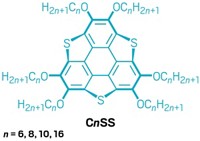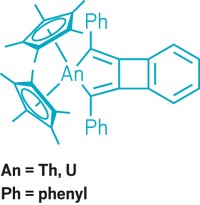Advertisement
Grab your lab coat. Let's get started
Welcome!
Welcome!
Create an account below to get 6 C&EN articles per month, receive newsletters and more - all free.
It seems this is your first time logging in online. Please enter the following information to continue.
As an ACS member you automatically get access to this site. All we need is few more details to create your reading experience.
Not you? Sign in with a different account.
Not you? Sign in with a different account.
ERROR 1
ERROR 1
ERROR 2
ERROR 2
ERROR 2
ERROR 2
ERROR 2
Password and Confirm password must match.
If you have an ACS member number, please enter it here so we can link this account to your membership. (optional)
ERROR 2
ACS values your privacy. By submitting your information, you are gaining access to C&EN and subscribing to our weekly newsletter. We use the information you provide to make your reading experience better, and we will never sell your data to third party members.
Synthesis
Antiaromaticity flips single-molecule switch
Study shows comparatively unstable antiaromatic molecules can work well in molecular electronic devices
by Mitch Jacoby
November 6, 2017
| A version of this story appeared in
Volume 95, Issue 44
Ultrasmall electronic devices require ultrasmall components. That’s why scientists have been working for the past few decades on electronic circuitry in which function is controlled by just a single molecule. Those molecules nearly always sport conjugated aromatic backbones because aromaticity in those molecules usually goes hand-in-hand with enhanced conductivity. But a team led by Latha Venkataraman and Luis M. Campos of Columbia University and Jeffrey B. Neaton of Lawrence Berkeley National Laboratory has shown that aromatic isn’t the only way to go: The team has demonstrated a highly conducting, reversible, single-molecule switch based on antiaromaticity (Sci. Adv. 2017, DOI: 10.1126/sciadv.aao2615). In classical organic chemistry, Hückel’s rule states that conjugated cyclic molecules with 4n+2 π electrons exhibit enhanced stability because they are aromatic. Related molecules with 4n π electrons are comparatively unstable and described as antiaromatic, a concept pioneered by Columbia’s Ronald Breslow, who died Oct. 25. Intrigued by the possibility that a so-called unstable antiaromatic molecule might function as a switch, the team used a scanning tunneling microscope to pin a nonconducting thiophenylidene derivative (TBTP, shown) between gold electrodes. They showed that a quick electrooxidation step reversibly removes two electrons, converting the neutral molecule to a highly conducting antiaromatic dication that works stably and reproducibly as a switch.





Join the conversation
Contact the reporter
Submit a Letter to the Editor for publication
Engage with us on Twitter